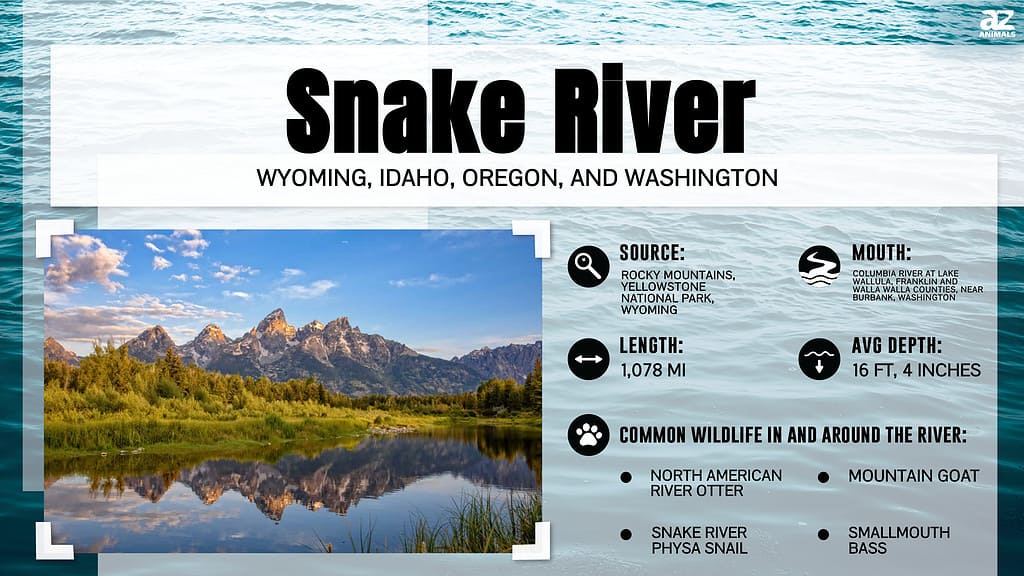
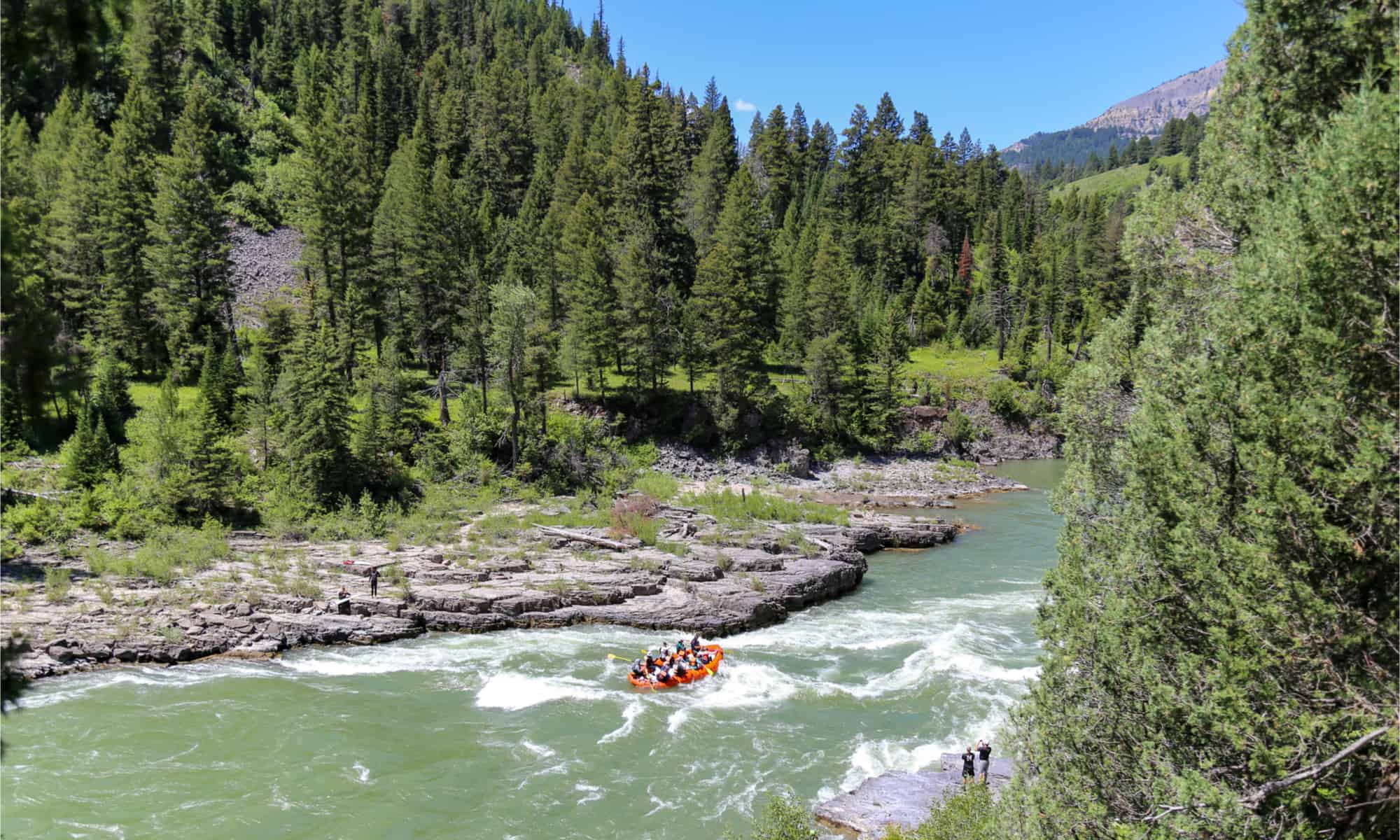
The Snake River winds through Jackson Hole, Wyoming as well as through Idaho, Oregon, and Washington.
©CSNafzger/Shutterstock.com
The Snake River is 1,078 miles long and flows through Wyoming, Idaho, and Washington before emptying into the Pacific Ocean. Its headwaters begin in Yellowstone National Park, where a volcanic hotspot lies underneath. Volcanic activity and flooding during the last ice age created this winding river. Its waters have a rich history of having provided vital resources to the Shoshone Native Americans and the Lewis and Clark expedition. The Snake River also has diverse wildlife that lives in and near its water. And contrary to its name, the river isn’t full of snakes. But you can still find some that swim in it or live near the banks. Meet the six snakes of the Snake River and learn how to identify them and discover their habitats.
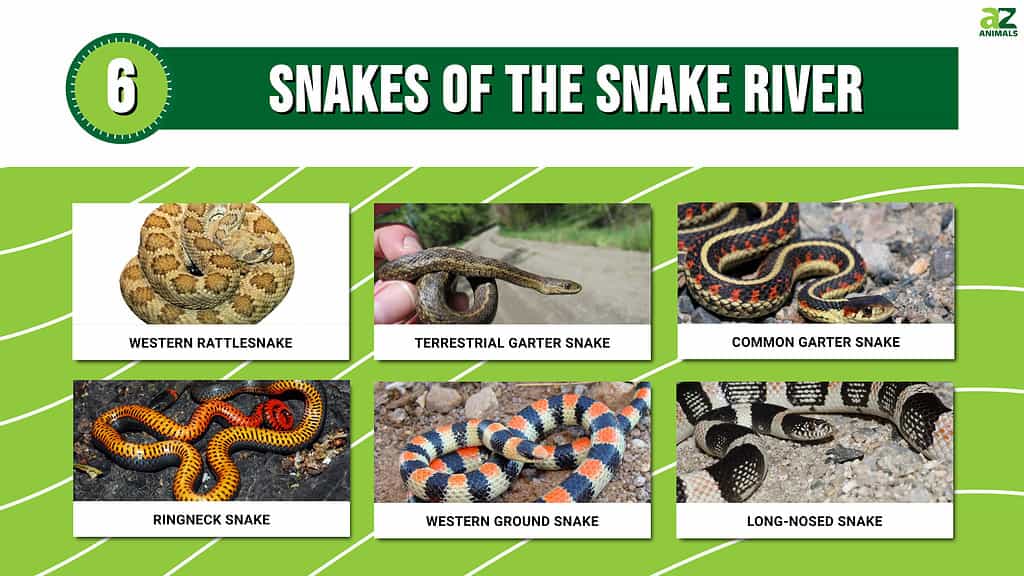
Prairie or Western Rattlesnake

Prairie rattlesnakes can be found in the Snake River.
©taviphoto/Shutterstock.com
The western rattlesnake is more commonly known as the prairie rattlesnake (Crotalus viridis). It is a highly venomous pit viper snake most often found in the western United States east of the Sierra Nevada and Cascade Mountain ranges, southwest Canada, and northern Mexico. These dangerous snakes are typically around three to 5 feet long, with a triangle-shaped head; patterned with darker brown oblong blotches along their back against a ground of brown and gray scales. Their tan scales give way to dark and white bands near the base of their tail, just above the rattler.
Because this snake blends so well with its habitat, be careful where you step and listen for the infamous and dreaded rattle! During hot daytime hours, this rattlesnake will coil itself near shrubs, rocks, or piles of debris; it may even seek shaded shelter within an underground burrow. It also finds similar habitats during winter, maybe even a cave which is perfect for brumation.
Note: This snake’s taxonomy has been the subject of a revision in the last several years. Several of the subspecies were reclassified as species. These include the Northern Pacific Rattlesnake (C. oreganus) and the Great Basin rattlesnake (C. lutosis); both snakes also inhabit areas of the Snake River.
Terrestrial Garter Snake
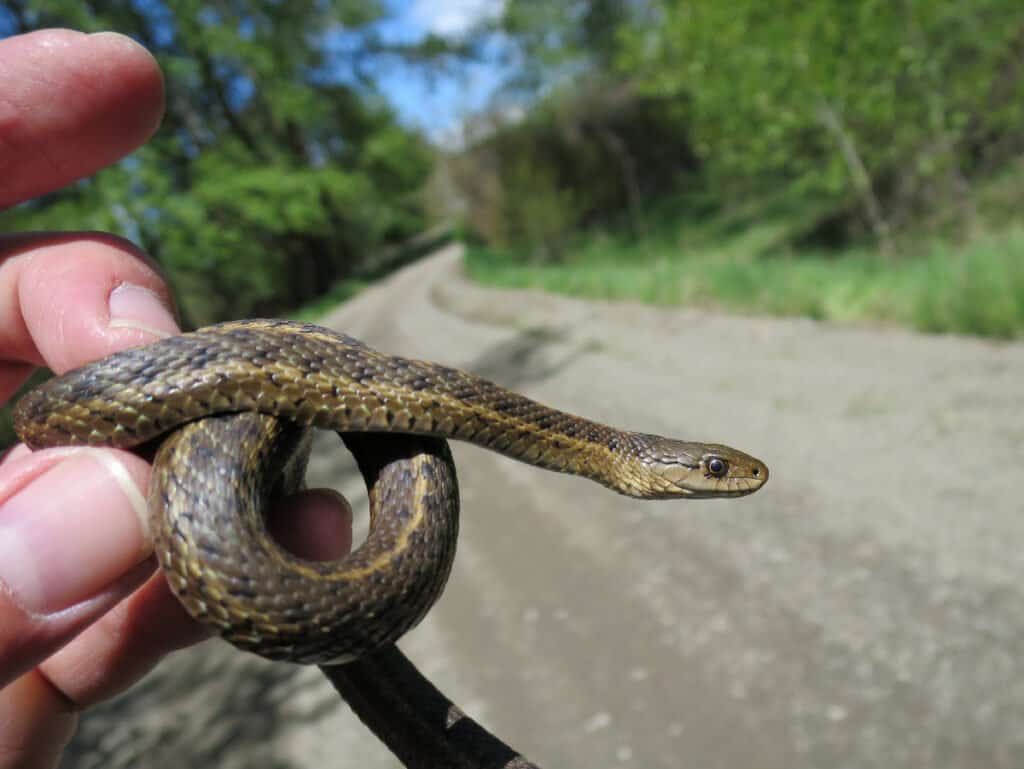
Terrestrial
Garter Snakes
are the most abundant aquatic snake of the Snake River.
©Randy Bjorklund/Shutterstock.com
The Terrestrial garter snake is a colubrid from western North America. It is a highly variable species that is often tricky to identify. Most have a yellow, orange, or white dorsal stripe with two stripes of the same color on each side of their body. These medium-sized snakes can grow up to three feet. Their saliva contains a mild neurotoxic venom, although they are not considered to be dangerous to humans.
This garter snake species inhabits an extensive habitat range, including grasslands, woodlands, and forests. The garter snakes near the Rocky Mountains are semi-aquatic and the most water-loving snake near the Snake River. You will often find them near the water, feeding on fish and tadpoles. In fact, aquatic species make up the majority of the diet of these inland snakes.
Common Garter Snake

Garter snakes
have three stripes that run the length of their body.
©iStock.com/randimal
Indigenous to North America, the common garter snake is actually less common than the Terrestrial garter snake, at least in the Pacific Northwest. Most of these garter snakes have black, brown, or green bodies with yellow stripes. This snake species is relatively thin and can grow up to four feet long, although most stay much smaller. Like other garter snakes, they can come in a wide variety of colors.
They prefer to live near water, whether rivers, streams, ponds, or wetlands, but they also inhabit forests, fields, and prairies. They are diurnal but adjust their activity depending on the season. During summer, they are most active in the early morning and late afternoon, while in winter they prefer to slither around during the warm afternoons. This garter snake also has a mild venom that can cause localized reactions in humans. It also secretes a foul-smelling fluid when handled.
Ringneck Snake
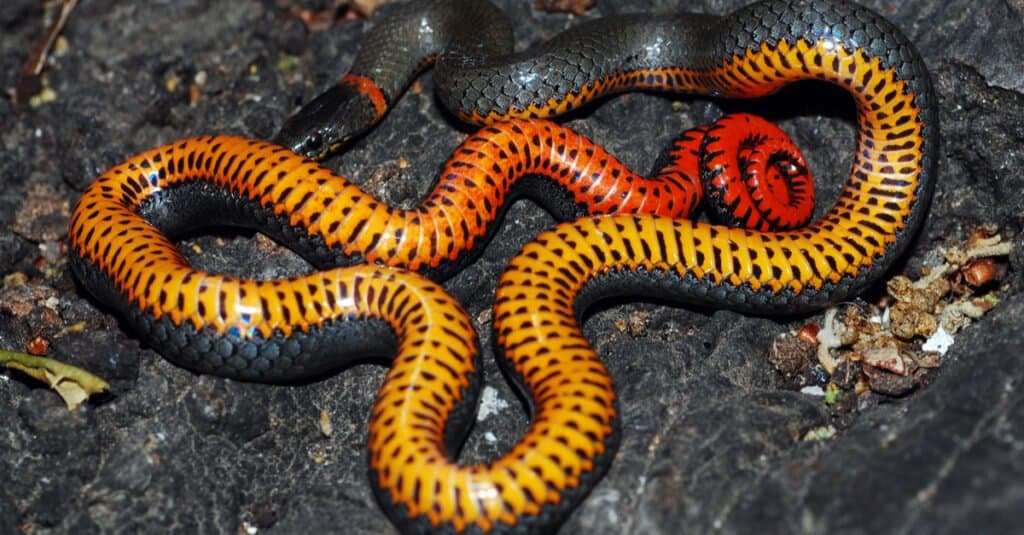
Ringneck snakes
prefer areas with abundant cover.
©Jason Mintzer/Shutterstock.com
One of the more colorful reptiles around Snake River is the ringneck snake, a colubrid species found throughout much of the United States. It has a dark dorsal color varying from olive to brown to black, with yellowish-orange to bright red coloration on its underside. It also has a distinctive yellow, red, or orange band (or ring) around its neck, hence the name. This smaller snake species can grow to a little over a foot.
Ringnecks occur in a variety of habitats but prefer areas with abundant cover and denning options. The Northern and Western subspecies (those found around the river) are either in woodlands near rocky hills or wet environments with woody debris. This secretive snake is nocturnal and rarely seen by humans. If you do happen to cross one, don’t panic. This snake’s venom is ineffective on people, and they won’t bite unless harmed or provoked.
Western Ground Snake

Western Ground Snakes inhabit areas in Southwest Idaho near the Snake River.
©Matt Jeppson/Shutterstock.com
The Western ground snake, also known as the common ground snake, is a colubrid species endemic to North America. This small snake is typically around half a foot up to a little over a foot long and prefers to live around the Snake River, as opposed to in it. Its color and pattern vary widely from brown, black, red, and orange, with some featuring solid color, banding, or striping.
These nocturnal snakes prefer dry, rocky areas, and you can often find them near the road or in drainage ditches. They like to burrow into loose, sandy soil near hillsides at lower elevations. You can find this species in the southwest corner of Idaho, close to the river. They have a docile nature and are not venomous, so there is no fear of being bitten by western ground snakes.
Long-Nosed Snake
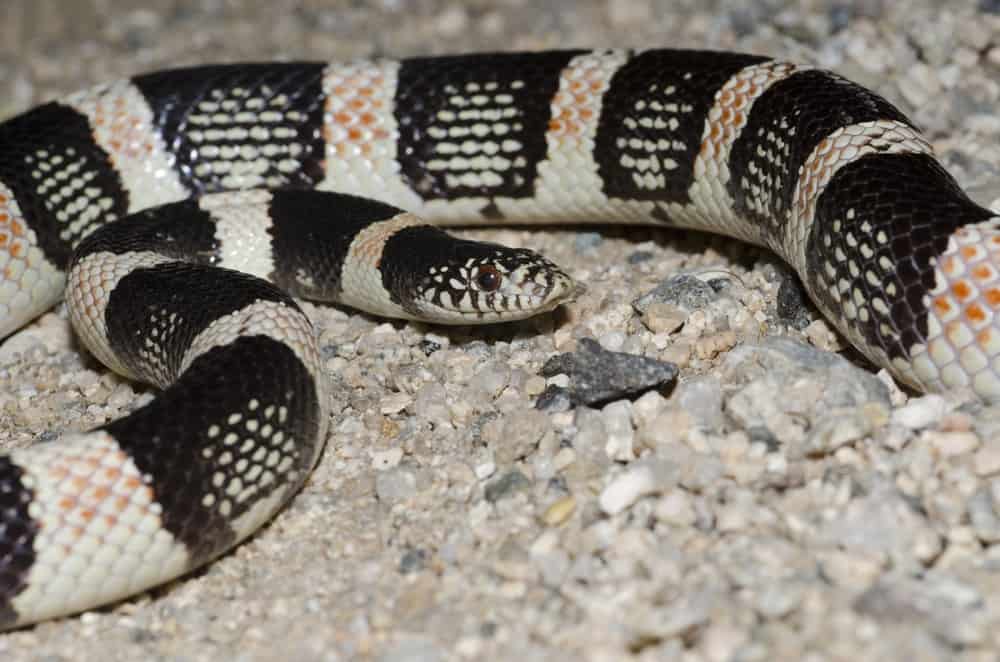
The long-nosed snake is shy and hard to spot.
©Jason Mintzer/Shutterstock.com
The long-nosed snake is a species of Colubridae endemic to North America. It gets its name from its long, upturned snout and features a cream-colored body with black and red banding. Its length typically reaches from 1.8 feet to 2.6 feet, with the largest recorded topping three feet.
While its preferred habitats are deserts, grassland, and shrubland, you can occasionally find them in the southwest corner of Idaho near the Snake River. The long-nosed snake is shy and hard to spot because of its nocturnal behavior and its liking for burying itself underground. These snakes are non-venomous and don’t pose a threat to humans. However, they will emit foul musk and blood as a defense mechanism.
Amphibians Found At Snake River

The Northern
leopard
frog is a species currently listed as vulnerable.
©Jason Patrick Ross/Shutterstock.com
The Northern leopard frog, currently listed as vulnerable in Idaho, is a small species of frog that grows up to 4.5 inches in length and is known as an opportunistic feeder that will ingest anything it can fit into its mouth, from ants, birds, and garter snakes to even its own kind. Considered a true frog species, they have a call that sounds like a snore but when frightened or grasped, they sound like they are screaming very loudly.

Bullfrogs are an invasive species on the Snake river.
The largest frog in North America, with lengths of up to 8 inches and weights reaching 1.5 pounds, is the bullfrog. Although this frog is not native to the Snake River and Idaho, it has expanded its territory to this area and has come to dominate these wetlands and threaten the native species. Because it is considered an introduced species, it is not protected. Males elicit the croaking sound during mating season, which some believe resembles the mooing of a cow, which is how this amphibian earned its name, “bull” frog.
The photo featured at the top of this post is © Nathan A Shepard/Shutterstock.com
Discover the "Monster" Snake 5X Bigger than an Anaconda
Every day A-Z Animals sends out some of the most incredible facts in the world from our free newsletter. Want to discover the 10 most beautiful snakes in the world, a "snake island" where you're never more than 3 feet from danger, or a "monster" snake 5X larger than an anaconda? Then sign up right now and you'll start receiving our daily newsletter absolutely free.
Thank you for reading! Have some feedback for us? Contact the AZ Animals editorial team.






